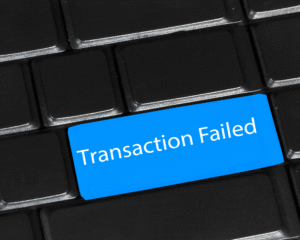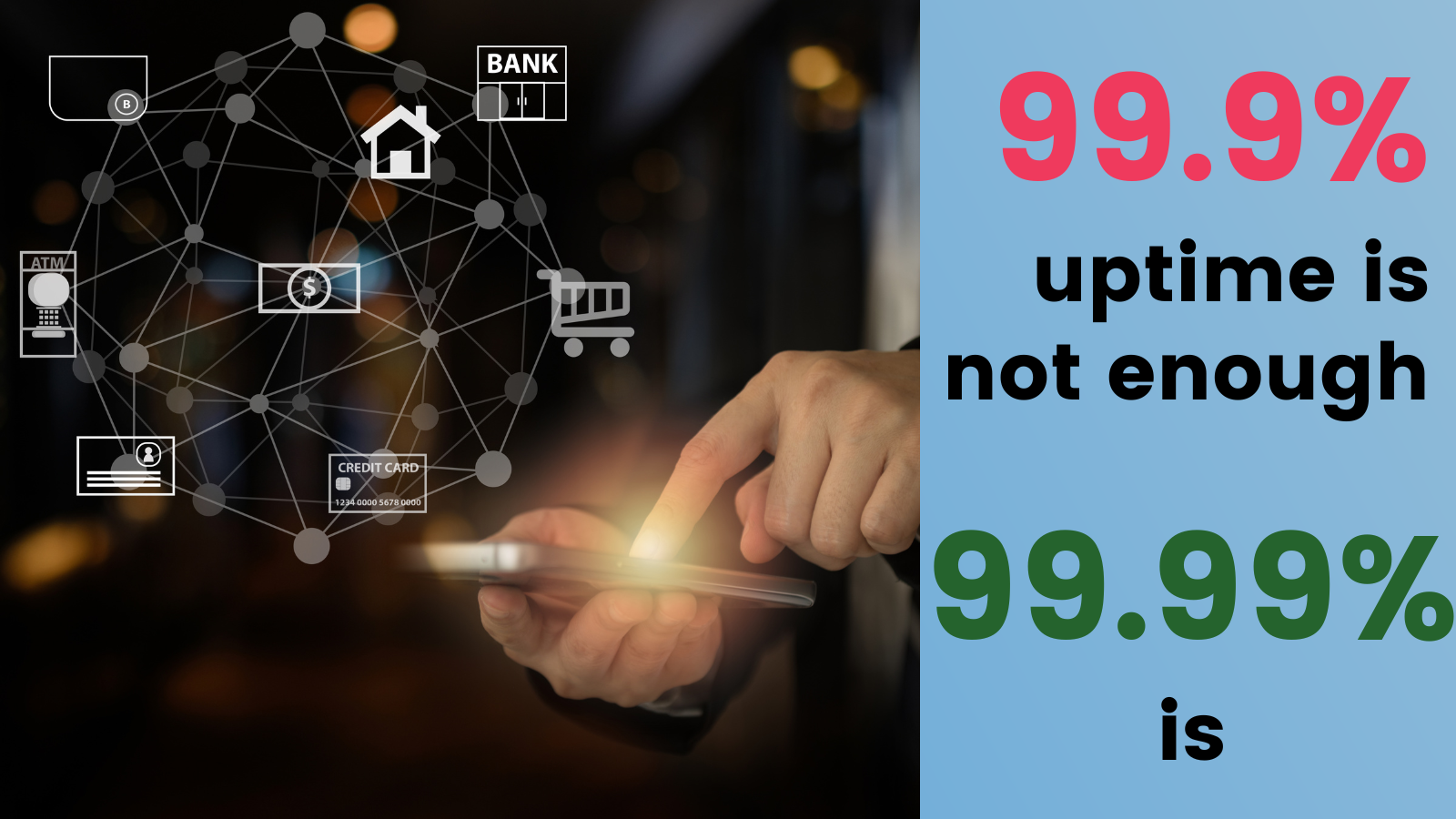A system downtime, whether planned, brief, or carried out as intended, can have real consequences for a financial institution. For a user, it is still a disruption. Customers expect to access their accounts 24/7. It is a customer expectation vs business promise. And 99.9% uptime alone is not enough.
Customers Want 24/7 Banking Promise
According to recent data from Statista,
Over 73% of banking customers in Asia-Pacific use digital services weekly, and more than 60% expect them to be available around the clock.
These are expectations that require every institution to commit to Service Level Agreements (SLAs) with uptime guarantees of 99.9% availability. Despite the fact that this sounds nearly perfect, it still gives room for meaningful amounts of downtime (up to 43 minutes per month), which is nearly 9 hours annually.
What is Uptime?
 According to UPTIMIA, uptime is the amount of time a system is operational and available for use.
According to UPTIMIA, uptime is the amount of time a system is operational and available for use.
Uptime is the period when a bank’s system or service is fully accessible to customers, without any interruptions, delays, or failures.
This means:
-
A customer is able to check their balance at at any hour of day or night.
-
A company or business can pay salaries on a public holiday.
-
An individual can buy airtime any time.
-
And a farmer in a remote area is able to access mobile banking services at any moment.
That means 24 hours a day, 7 days a week access with no exceptions.
A service with 100% uptime means that throughout a given, defined period, the service was never unavailable. No errors were reported, as well as outages.
Calculating Uptime
Uptime is typically measured as a percentage over a specific time period. This period is usually a month, or a year.
High uptime: is when the system is reliably available to your customers, or users.
Example:
If your mobile banking system is available for a full day, with no reported interruptions, then, that day’s uptime was 100%.
What is Downtime?
 Downtime is the opposite of uptime. It is the period during which a system or service is completely unavailable or not functioning as it should, or expected.
Downtime is the opposite of uptime. It is the period during which a system or service is completely unavailable or not functioning as it should, or expected.
Downtime can be:
-
Planned (e.g., maintenance windows)
-
Unplanned (e.g., system crashes, network failures)
Every period of downtime, short or long, can really disrupt user experience, cause financial losses or even reputational damage.
Service Level Agreement (SLA)
An SLA is a formal agreement between two parties; a service provider and a client. SLA defines what the customer expects in terms of service performance level. The SLA is commonly in terms of availability or uptime.
99.9% SLA
-
A 99.9% SLA means the service provider guarantees that the service will be available 99.9% of the time over a given period.
How much downtime is allowed in a 99.9% SLA?
A 99.9% SLA means that the system/service should be available and operational 99.9% of the given period. This period can be a day, a month, or a year. This means the system’s reliability is near-perfect. However, even that 0.1% difference allowable is quite a measurable downtime.
To help you understand the impact of the 0.1%, the next section is a breakdown into actual minutes and hours of allowable downtime across different periods, or timeframes.
Calculating Downtime
Allowed downtime is calculated using the following basic formula:
Downtime = (1 – SLA) × Total time in period
From the above formula, let’s translate 99.9% into downtime across different time frames:
- Calculating Monthly Downtime (30 days)
Step 1: Calculating Total Time
1 day = 24 hours
30 days = 30 × 24 = 720 hours
Each hour = 60 minutes
720 hours = 720× 60 = 43,200 minutes
Therefore, the total minutes in 30 days = 43,200
Step 2: Convert SLA Percentage to Decimal
99.9 ÷ 100
= 0.999
The 0.1% is the room the system can be unavailable, but must be available 99.9% of the time.
So:
-
Downtime allowance = 1 – 0.999
-
= 0.001
This is the downtime ratio
Step 3: Multiply Downtime Ratio by the Total Time
Allowed downtime in minutes is calculated using the formula below:
Downtime ratio × The total number of minutes
0.001 × 43,200
= 43.2 minutes of downtime per month
2. Calculating Weekly Downtime (7 days)
- Total minutes in 7 days
= 7 × 24 × 60
= 10,080 minutes
- Downtime allowed per week
= (1 – 0.999) × 10,080
= 0.001 × 10, 080
= 10.08 minutes
3. Calculating Yearly Downtime
- Total minutes in 365 days
= 365 × 24 × 60
= 525,600 minutes
- Downtime allowed per year
= (1 – 0.999) × 525,600
= 525.6 minutes (about 8.76 hours)
Calculating Downtime is Not a License to Go Offline
99.9% is an SLA percentage often used as performance benchmarks. Therefore, it is important to remember that the above calculations are not permissions to allow downtime. We are using these to mathematically translate system availability into quantifiable units of time.
Digital banking channels must be engineered for zero service interruptions, be it every day, every week, or every month.
Benchmark: When SLAs Fall Short
In a 2024 daily report from a regional bank, over 36,000 transactions were processed across its digital channels. Of these transactions, 749 failed to meet SLA thresholds, resulting in a 97.93% overall SLA performance.
SLAs that stood out from the report:
-
Cash withdrawal services was 69.49%. This is far from acceptable in a 24/7 banking environment.
-
Balance inquiries was 86.36%.
-
Purchase transactions of over 35,000, achieved 98.01%
These percentages contributed heavily to the SLA dip, and 97% uptime does not sound impressive.
Every transaction that fails means customer experience is disrupted. That could also mean a decline in cash withdrawal, an unsuccessful purchase, or a failed balance inquiry.
Assuming each failed query, or transaction affected a particular user, that sums to 749 frustrated, and disgruntled customers, in only one day. This further means that hundreds of transactions failed that day.
According to Research from nojitter,
1 in 5 banking customers switch providers because of a bad digital experience.
Even if only 1% of those affected decide to switch banks, that is 8customers lost in just one day. For a tier 1 or tier 2 bank, that could mean over 1,000 customers lost in a year due to downtime dissatisfaction alone.
Therefore, service continuity is now a core differentiator.
But 99.9% Uptime Alone is Not Enough
The 99.9% uptime has long been the industry benchmark. However, the bar is rising by day. Digital banking leaders no longer see the minimum of 99.9% availability as sufficient. 99.99% is.
99.9% availability means there is still room for downtime. However, 99.99% reduces that to nearly zero, which is far more realistic in meeting customer expectations.
99.9% is a compromise no financial institution can afford.
Because in banking:
Every minute of unavailability is a business vulnerability:
-
It leads to loss of customer trust.
-
It disrupts key revenue-generating activities.
-
It exposes operational challenges between business and IT.
The traditional model of stitching APIs together and hoping they withstand pressure is no longer viable. Digital banking channels now demand a strategic foundation, one that’s resilient by design.
Rethinking Your Channel Infrastructure
Financial institutions need more than just uptime. Channels must be resilient, high-performing, and reliable, especially when the CBS is down.
Unlike traditional integration layers, such a system should offer:
-
Channel independence from the CBS. This independence enables all the channels to remain available during CBS outages or maintenance periods.
-
Real-time fallback. This ensures your institution’s customers access services without any disruption.
-
Decoupled processing. For handling routine transactions and requests, such as balance checks and airtime purchases outside the CBS.
-
178+ pre-integrated APIs. To cover everything, i.e., payments, KYC, fraud alerts, notifications, etc.
-
Sub-200ms response times. Critical for delivering smooth user experiences.
-
Built-in monitoring and compliance tools. For visibility into live traffic, performance, and suspicious activity.
Leading Banks Are Doing Things Differently
Based on NLS Tech Solution’s work with Tier 1 and Tier 2 institutions, leading digital banking teams are transitioning to a new architectural approach that focuses on:
-
Transaction Offloading
Moving routine, high-volume transactions away from the CBS. This ensures performance and stability. -
Smart Data Syncing
Replacing batch updates with near-real-time, need-based synchronization that’s faster and lighter on infrastructure. -
Service-Layer Intelligence
Introducing logic at the orchestration layer, handling retries, routing, throttling, and failover dynamically. -
API Governance
Treating APIs as critical infrastructure, where they are monitored, controlled, and analyzed like any CBS component. -
Always-On Availability
Ensuring digital channels remain fully available even during CBS maintenance or unexpected system load.
Stop Guessing. Start Controlling Downtime
If your channels are experiencing downtimes this month, you’re already breaching a 99.9% SLA.
TERAFIN Was Built to Stop That
With TERAFIN, it is easier to provide self-healing and responsive digital banking services.
The results will speak for themselves:
-
80% reduction in channel-related outages
-
3× faster time-to-market for launching new digital products
-
60% lower infrastructure and support costs
-
Zero unplanned downtime during CBS maintenance windows
See How Top Banks in Africa use TERAFIN to hit 99.99%
Uptime +
Book a walkthrough now
No sales pitch, just a look at the numbers, architecture, and uptime benchmarks.
Talk to a Channel Infrastructure Expert
Email: sales@nlske.com







